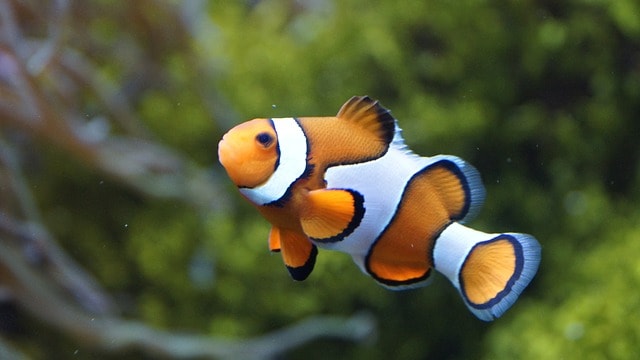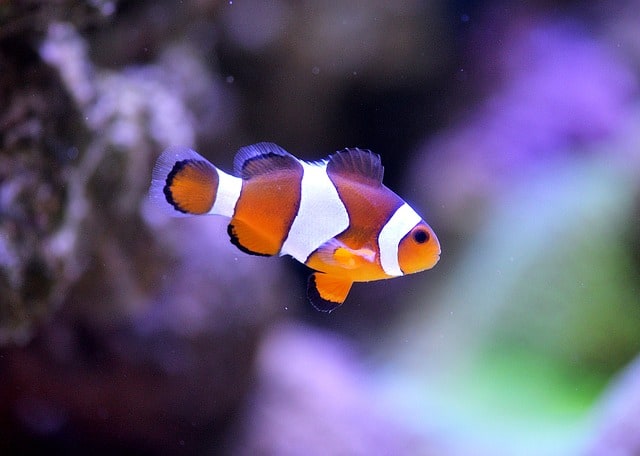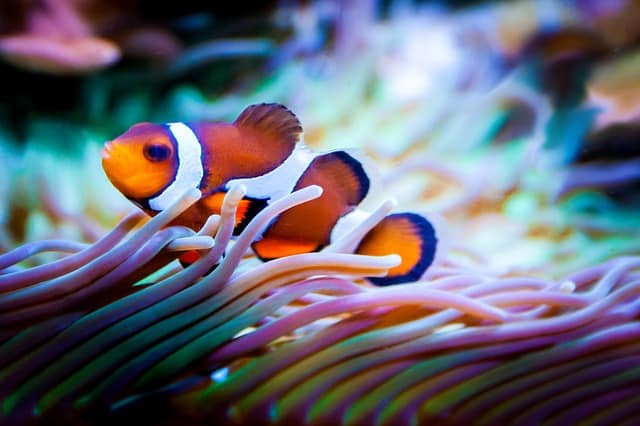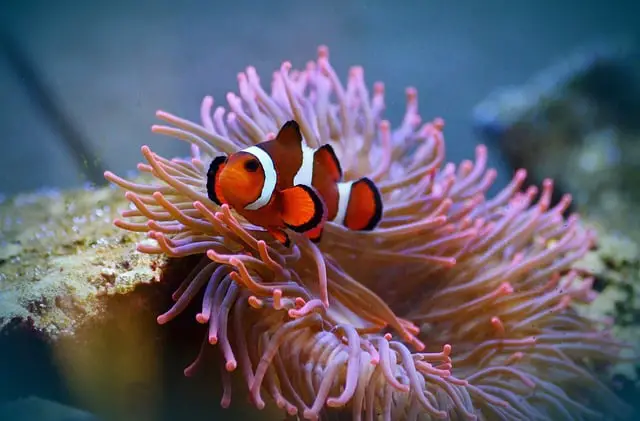A sea anemone is a typical aquatic creature found in many saltwater tanks, especially those containing clownfish. It’s considered a type of predatory marine animal that got its name from a flowering aquatic plant of similar appearance. As an aquarium hobbyist, you may be thinking about adding an anemone to your saltwater tank and are wondering if it could potentially kill your fish? Well, the answer is…
Yes, as anemones are carnivorous, they can kill (and then eat) certain types of smaller fish by stinging them to death. Though cardinalfish and damselfish can live amicably with sea anemones in captivity, the only species that truly benefits from their presence is the clownfish. In general, fry as well as sick or dying bottom dwelling fish are at a greater risk of being killed by anemones.
Now that you know anemones can injure and possibly kill your fish, let’s take a look at this topic in more detail. Moving through this article, I’ll explain whether or not most saltwater aquarium fish can survive an anemone sting. I’ll also discuss which species can live safely with sea anemones in a community tank and how clownfish (in particular) are affected by both the presence and absence of anemones.
So, if you’re ready to dive deeper into the aquatic world of the sea anemone and learn more about its cohabitation with other fish in captivity, then let’s begin!
What Fish Can Live with Anemones?
There are very few species of saltwater fish that live peacefully with sea anemones, especially in a captive environment. Since anemones are predatory creatures with the ability to sting fish to death, only those with strong exterior protection (i.e. slime coating) can survive.
While types of cardinalfish and damselfish can be kept with anemones in a community tank, only the clownfish benefits from this symbiotic relationship. The clownfish provides the anemone with nutrients in the form of waste and the anemone, in turn, offers protection by way of shelter for the clownfish.
This doesn’t mean you can’t have any other type of marine fish in a tank with anemone’s because you can. I have had scooter blennies and mandarin gobies in the same tank as a couple anemones with no problems.
Anemones by nature are slow moving creatures, so unless a fish is injured or already dying, it’s highly unlikely your anemone will chase any fish down to sting it.
One thing to consider is if you have a strong current from a power head and a fish were to get caught in the current upstream from an anemone. It could then potentially be swept away into the tentacles of an anemone.
Can a Fish Survive an Anemone Sting?
The only fish that can survive an anemone sting are ones with an extra thick, protective mucus coating or ‘slime coat’ on their bodies. It’s essential that fish acclimate to their ‘host’ anemone beforehand. Otherwise, they won’t be able to freely move through the anemone’s tentacles without being stung.
Small fish that are sick, dying or resting on the bottom of the tank are more susceptible to anemone stings in a saltwater aquarium. Those that are active and prefer to swim in the middle or near the surface of the tank are far less likely to be stung.
Will Tube Anemones Eat My Fish?
Tube anemones, for the most part, aren’t a threat to fish. Carpet anemones, on the other hand, are larger and will eat small fish if given the chance. Should a fish happen to touch its extremely sticky tentacles and get stuck, then the carpet anemone will often sting it to death and have it for dinner!
Rock flower anemones and mini maxi anemones also tend to be safe for most reef tank set-ups. Bubble tip anemones, however, are unpredictable and like to move from place to place along the substrate. This makes them more dangerous for small, bottom dwelling fish.
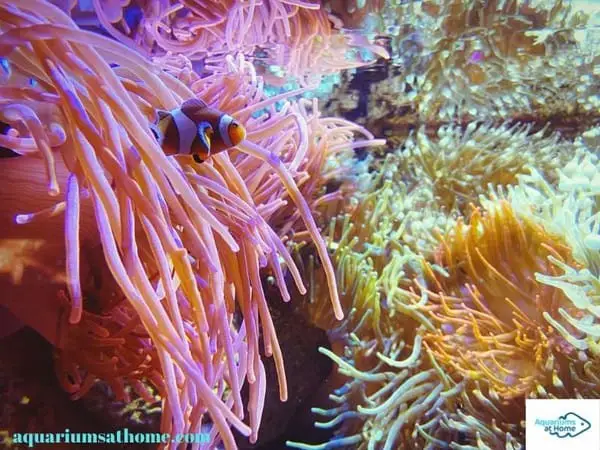
Will an Anemone Eat a Clownfish?
An anemone will not eat its host clownfish, or really any fish for that matter – unless it’s sick, dying, or already dead perhaps! Sea anemones in the wild prefer to eat clams, crab, urchins, mussels, and other free roaming aquatic invertebrates.
In a captive environment such a saltwater tank, anemones will feed on protein-rich foods such as marine fish flakes, mysis shrimp, and tiny pieces of scallop. It’s recommended that you feed them once or twice a week, with smaller anemones being fed more often (up to three times a week) than larger ones.
Make sure you’re making a conscience effort to feed your anemones. I have heard some aquarium hobbyists say they just feed their fish and that the anemones will eat whatever’s leftover. That’s a dangerous game to play. In most cases, your anemone won’t get enough to eat and end up suffering and dying as a result.
Can Clownfish Hurt an Anemone?
While it’s highly unlikely for an anemone to harm a clownfish, a clownfish can (and will) – albeit unintentionally – hurt an anemone. When this happens, it’s usually the result of a too-large or too-aggressive clownfish acclimating to a smaller, weaker anemone.
Your best bet is to purchase a juvenile or smaller species of clownfish (such as the true percula) and a sizeable carpet anemone, so the fish has a lesser chance of ‘stressing out’ the anemone. Be careful with maroon or tomato clownfish as they grow quite large and tend to be more hostile in nature.
Can Clownfish Live without an Anemone?
Though clownfish can live without an anemone in captivity, they’re less likely to survive without one in the wild. Anemones provide both shelter and protection from predators. In an aquarium, a clownfish will be healthier and happier with an anemone as they need that symbiotic relationship to thrive.
Tank-raised clownfish aren’t as aggressive as wild-caught clowns. They tend to be less territorial in a captivity and don’t rely on an anemone for survival. They’ve been raised with other fish and are used to ‘sharing space’. That said, a captive clownfish will indeed host an anemone if there’s one in the tank.
I can personally verify that clownfish will live a long healthy life without a host anemone. I have owned a couple false percula’s that lived for years and had minimal exposure to any anemone’s.
How to Reduce the Risk of Anemones Stinging Aquarium Fish?
It’s imperative that you place your anemone in a well-established tank with the ideal water conditions for its species. Some like to attach to rocks whereas others prefer to bury themselves in the substrate. Make sure you know what your anemone favors in advance, but don’t be surprised if it moves later on!
Then, add fish that aren’t bottom dwellers to the tank. Apart from the Benggai cardinalfish, for example, that like to swim around the corals in a saltwater tank and can withstand a sting or two from anemones, it’s safer to keep fish that are active and tend to swim in the middle or near the top of the tank.
What Fish Should Never be Kept with Anemones?
Carefully choosing tankmates for an anemone is essential to the overall health of a community saltwater tank. Don’t keep angelfish, pufferfish, or butterflyfish with anemones as they’ll instinctively peck at their tentacles which will ultimately kill them.
As well, fry should always be removed from a tank with anemones as their minute size makes them easy prey for anemones. Since fry also tend to stick close to their parents and/or the birthing site (near rocks or plants along the substrate), this also makes them prime targets for opportunistic anemones.
Conclusion
To conclude, an anemone can kill small, sick, or dying fish that get caught in their tentacles by stinging them to death. Apart from certain types of cardinalfish or damselfish, the only species that not only survives but thrives in the presence of an anemone is the clownfish.
Baby fry and tiny bottom dwelling fish are at the greatest risk of being killed and eaten by anemones. It’s important to research different species of anemones beforehand to determine if they’re compatible with the majority of fish in your aquarium.
I hope this article has answered your questions about anemones and their compatibility with saltwater fish in a community tank environment. Thanks for reading and good luck with your aquarium hobby.
Related Posts
Why Do Clownfish and Sea Anemones Pair Up?
Do Clownfish Attack Other Fish?



